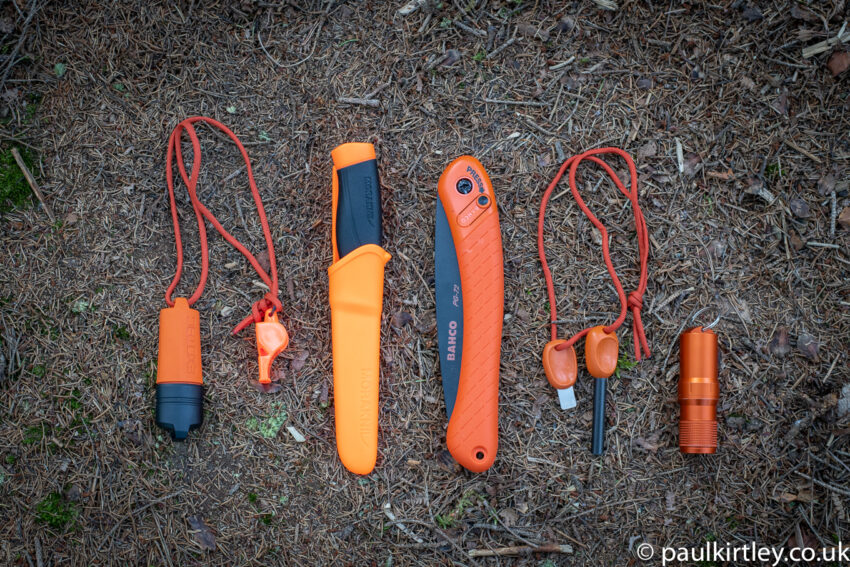
The Value of Visibility: Considering the Colour of Critical Kit
In the bushcraft world, we tend to like muted, natural colours. These are colours mirroring the colours of our local natural environment, typically shades of green and brown. Having a backpack, clothing and tarp of low-key natural shades helps us blend in with nature. We make less of a visual impact on others, we are more likely to see wildlife and, perhaps, we feel more in tune with our surroundings. We tend to extend this aesthetic to smaller items too. This, however, can be a potentially serious disadvantage. We need to consider the colour of critical kit.
I think there’s a strong argument for important pieces of equipment being brightly coloured. The items of equipment I particularly have in mind are critical on-person items. This logic could also be extended to other items in your daypack or backpack. The important on-person items warrant particular attention, though, as they are both important and typically small, thus relatively easy to mislay or lose outright.
Orange is a Colour of Safety and Warning
Orange is widely used internationally as a warning or safety colour because it is inherently highly visible. More specifically, particular shades of orange are especially conspicuous to the human eye in outdoor settings.
In many countries traffic cones and traffic barrels are typically orange. In the USA temporary highway signs are also orange.
High-visibility (a.k.a “hi-vis”) vests, or tabards, are often bright orange, usually combined with some reflective material, so they can be seen in low light when illuminated by a headlight or flashlight.
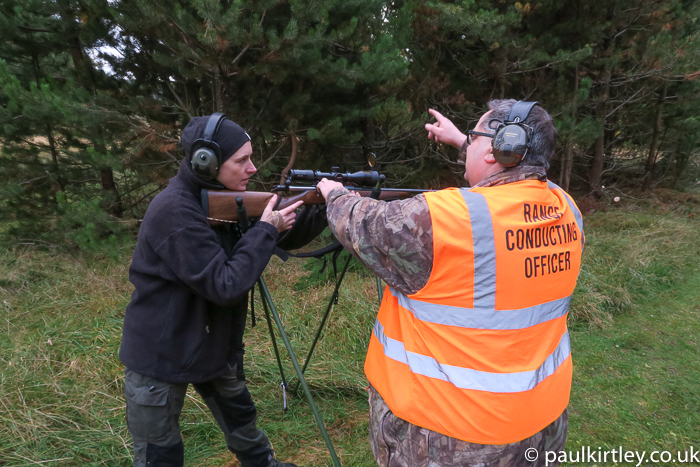
Modern liferafts and lifboats are typically orange. RNLI rescue lifeboats are orange (here’s why).
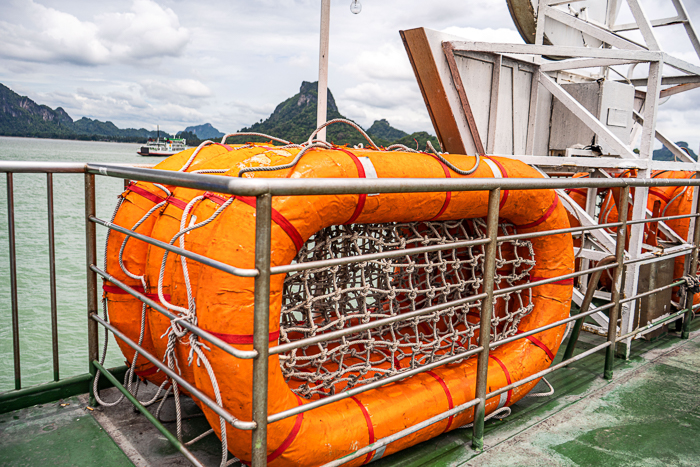
The so-called “black box” flight recorders in aeroplanes are actually orange, so they can be more easily found.
Hunters often wear clothing with elements of orange so they are more visible to other hunters (more on this below).
There is a particular shade of orange that is designated safety orange. It has the HEX code #FF7900.
There is another particular shade of orange referred to as international orange, used in the aerospace and maritime industries. This is often specified, or mandated, as a colour for high visibility, including for some safety or survival equipment. It has the HEX code #FF4F00.
There are also some variations on international orange, used in applications such as the colour of the Golden Gate Bridge and large antennae, which are applied for the purposes of making them more conspicuous.
Orange Renders Survival Shelters Highly Visible
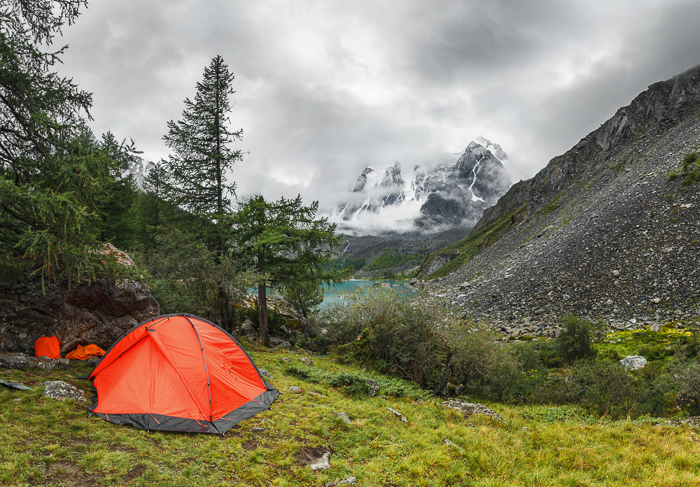
Group shelters (a.k.a “bothy bags”), emergency survival shelters, lightweight emergency sleeping bags, Blizzard Bags, and survival bags are often produced in orange to make them highly visible against vegetation, rocks or snow.
Why Hunters Wear Orange
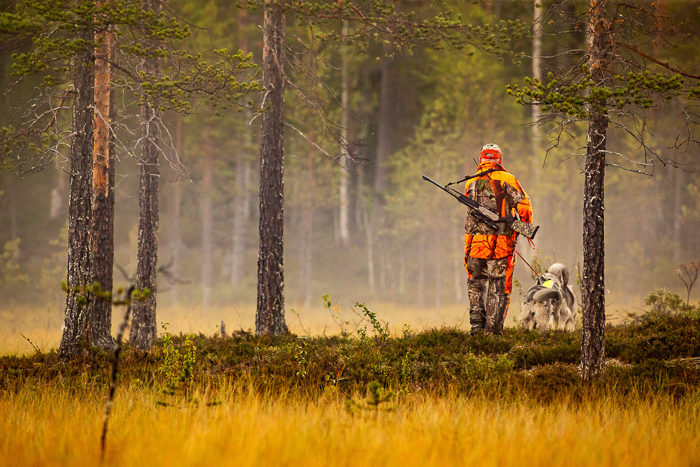
In some countries hunters are required to wear clothing with elements of orange so they are more visible to other hunters. Wearing otherwise drab, or camouflage patterned, hunting clothing with elements of orange makes hunters distinguishable from the naturally camouflaged prey species they could otherwise be mistaken for. Thus orange-clad hunters reduce the risk of being shot by other hunters. Moreover, hikers out during hunting season might also adopt blaze orange clothing, or other bright colours, to be more visible.
You might be wondering why orange doesn’t make the hunters visible to prey species? Hunters in many territories are often after deer, including moose. Deer vision is optimised for seeing well in the dark as well as spotting movement. The upshot of this is they don’t see orange anywhere near as well as humans do.
As explained very well on the National Deer Association website,“deer possess two (rather than three as in humans) types of cone photopigments allowing limited color vision. The cone photopigment deer lack is the “red” cone, or the one sensitive to long wavelength colors such as red and orange. These colors aren’t invisible to deer, but rather are perceived differently. Deer are essentially red-green colorblind like some humans. Their color vision is limited to the short (blue) and middle (green) wavelength colors. As a result, deer likely can distinguish blue from red, but not green from red, or orange from red. Therefore, it appears that hunters would be equally suited wearing green, red, or orange clothing but disadvantaged wearing blue.” Here’s the full article on deer vision.
Making Critical Kit More Visible
It’s undeniable that orange is a highly visible colour. In most natural environments, orange is conspicuous to humans. We can certainly apply this colour to critical items of kit to make them more visible.
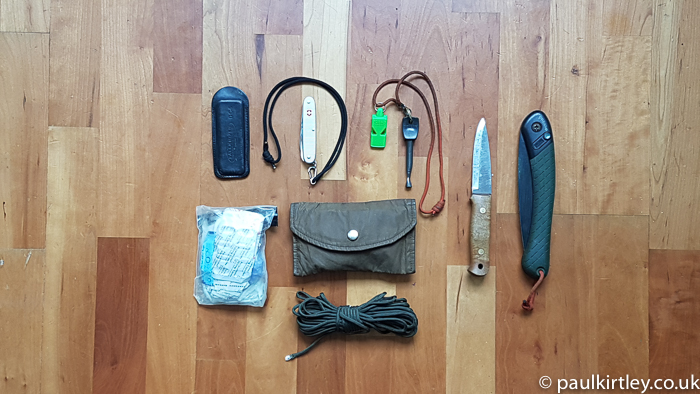
In the video embedded below I talk through some items that I think warrant consideration for being brightly coloured, as well as reasons why.
Get the transcript of the video.
Items to Consider Making More Visible
The following are on-person items to consider making more visible, as discussed in the video above. All have links to suitable items…
In addition, you might also want to consider the visibility of the following items…
- Pocket knife
- Compass
- GPS unit
- Headlamp or flashlight
- Karabiners
- Notebook
- Writing instruments
Methods of Making Items More Visible
Purchase Orange Items
The fundamental concept in this article, and in the video above, is acquiring items that are inherently brightly coloured. At the head of this article is a photo of items that are made to be orange by nature of the colour of the materials used for all or part of the item, for example the orange Fox 40 whistle, or the orange Bacho folding saw. This colouration is mostly by means of an orange plastic or rubberised material being moulded.
Items can also be purchased that are painted or anodised in the requisite colour, for example the Exotac match safe.
If you already own some items, however, you may want to make them more visible, rather than discarding perfectly serviceable equipment just because it is suddenly the “wrong” colour. Better, perhaps, to replace items over time.
Add Bright Lanyards
Having critical items attached to your person, belt, or clothing, with a lanyard, is fundamentally a sensible thing to do outdoors, particularly with important items such as a pocket knife, compass, whistle or ferro rod.
Such a lanyard can be brightly coloured so it, and thus the item it is attached to, is easily seen. Orange 550 paracord, builders line, or brightly coloured utility cord will serve well for this. Some cords have refective material woven into them so that they will brightly reflect light from a flashlight at night, so can even be found in the dark.
For more on lanyards see Belt Attachments For Bushcraft & Outdoor Life on my YouTube channel.
Change the Colour of the Item
You can purchase brightly coloured, and possibly reflective, adhesive tape and stick it onto parts of the item.
You can spray paint some items with a bright colour, such as orange. Just make sure the paint is durable enough for outdoor use and that it does not contain solvents that will damage the surface or structure of the item you are spraying.
Nail varnish can help too – this was recommended by several of my YouTube viewers. One option is to use fluorescent nail varnish to add a splash of colour to items. It’s hard wearing and sets quickly. Another idea was to use bright fly-tying line by Veevus Floss to wrap some colour onto an item, then cover this with clear nail varnish to seal it in place.
Review Your Gear With Visibility in Mind
Of course you don’t have to follow my thinking to the letter. What’s important is that when you review your kit with the intention of optimising it, include some thinking on the colour of important items. Make sure your gear is optimised for you and your activities.
Remember that some people are colour blind, so orange may not stand out to them. This is particularly important if you are considering the colour of group equipment in a camp or on a trip.
I’d Love To Hear From You
Let me and other readers know your thoughts on this article in the comments below. What do you do to reduce the chances of important gear? Do you think about the colour of critical kit? Do you use lanyards? Do you use tape or spray paint? Do you have other tips?
Related Material On This Website You Might Like
PK Podcast 028: Joe Robinet on His Love of Camping, Bushcraft & Making a Living on YouTube
PK Podcast 044: John Hudson, UK Military’s Chief Survival Instructor
A Framework For Preparing Yourself For A Survival Situation
Optimising a General Purpose Axe and Saw Combo for Wilderness Travel
19 thoughts on “The Value of Visibility: Considering the Colour of Critical Kit”
A length of reflective material paracord can be an absolute life saver. I added a piece to the draw string of a dark-blue pouch this weekend, makes a world of difference especially if you have a doggo in your camp and things…might not be where you last saw them.
A few lengths will also make it a lot easier to find your way back to camp in the dark.
Hi Thomas,
Indeed, the reflective cord can be very valuable in locating items. And, yes, adding the wild card of a pooch who likes to move your stuff, makes it even more important 🙂
Warm regards,
Paul
A useful article, thanks. A few years ago I was in a bothy in winter, went to the river to wash my bowl and spork. The spork was black, almost lost it in the twilight. Now I use a luminous green one.
Hi Gillian, I’m glad you found this article useful. Keeping track of eating utensils is more important than many credit. I’ve been on a number of trips where a member of the trip has mislaid their spoon or spork. It can become a real issue for them! It’s not a piece of safety or survival equipment but a spork or spoon is definitely a piece of kit that needs looking after!
Warm regards,
Paul
Great article Paul, thank you for laying down your thoughts on the matter.
The effectiveness of the visibility of hivis orange on a hillside at long distance is incredible. When I have forestry operatives weeding a hillside, I ensure they wear at least one item of hivis orange (hat, vest, trousers or jacket) and this results in being able to spot every operative extremely quickly from several hundred metres away. Without this, is it takes longer and you have to be much closer. Made even more difficult, of course, if visibility is low, due to weather.
I know which colour I would rather be displaying if I need to be located in a vast environment.
Best regards,
Sam
Thank you. I appreciate this wise counsel, including the suggestion of bright lanyards with reflective material. A couple of decades ago, backcountry camping alone in South Dakota on an exceedingly dark night under a small open tarp, my small black AA flashlight rolled down a slope into a deep cover of leaves. Feeling around in the dark proved fruitless, and I couldn’t see but maybe 3 meters from my camp. When two canids (probably curious coyotes) began circling my camp and calling to each other, too close for comfort but beyond my unaided sight, I can tell you, silly as it may now seem, that it worked on my already heightened imagination!
Nowadays, my headlamp even has a glow-in-the-dark holder.
A brightly coloured mobile phone case/cover could be another consideration and addition to the items list (or relevant device for communications/navigation as you mentioned Paul) more often than not the protective cases are black and if to be dropped or misplaced difficult to find (first hand experience of a phone slipping from my pocket whilst reducing a hedge, luckily recovered but not without some effort!) most definitely on board with this train of thought, great stuff, thankyou Paul!
Well put, my friend. The best cure is prevention. Don’t be caught dead without hi vis items.
Nice – yes, having important kit brightly coloured just makes sense! Similarly so for guys lines, and with reflective threads, more visible and folks are less likely to walk into / trip over those guys lines, and are obviously easily found at night with torch light (the Brotree brand is very good for this). I hadn’t seen the brightly coloured Bahco’s (cool) – searched for Silky’s and all the results had orange handles (spooky!).
Great article Paul. I have often looked at my kit in an outdoor setting and thought how hard it would be to find it when misplaced, which has happened especially when sharing a tool or piece of equipment. Going further than that I have thought about becoming lost and how visible I would be in the outdoors. I usually wear drab clothing with a green pack. A slip trip or fall into undergrowth or a body of water would render me invisible unless someone had FLIR capability. I am going to implement your plan for visibility with my equipment and my person. I have been involved in search and rescue for many years and have trained in the search process. We search for items of equipment we have lost in much the same way teams search for missing people eg, where I last saw it, most likely spots. Check again more thoroughly and expand the area is briefly it. You don’t have to stand out like a sore thumb but have at least one piece of clothing of the hi vis variety. An xxx large Hi vis t shirt you can throw on over all your layers maybe. This is great and completely overlooked sometimes for as little as aesthetics. Thanks Paul. Great stuff. Take care.
Great article Paul.
As a Scout leader I became aware of the need to highlight equipment many years ago when items started to get lost in the woodland environment.
My solution was to add fluorescent lanyards with retro reflective strands woven into them. The colour highlights items during daylight hours but the reflective strands really come into their own in darkness. Just wander around the area with a head torch and the lanyards light up. Since doing this small change we have not lost a single firesteel.
Definitely! I started attaching paracord lanyards to my kit when it finally occurred to me how much time I was wasting looking for my folding saw (green/black as pictured above) in the grass or leaves…
An unexpected bonus is that eventually you can identify different people’s gear by the lanyard colour and degree of fanciness!
i paint my outdoor tools blue. its not stealthy or taticool but there are few things in nature that are blue which makes them easer to find if i lay one down in the woods. i have had to search for orange, brown, camo or black tools only because they blended in with the leaves or other ground clutter on the forest floor.
Double your search time* by adding a tritium/GTLS (“Gaseous Tritium Light Source”) kit marker. These are available in dedicated forms for lanyard attachment (thick acrylic case + steel cable) or as small vials (sometimes very small indeed, enough to personalise kit with different colour combos) for DIY projects in many colours.
Costly, but very long lasting, and if it saves you some vital item at a crucial moment, then it could be a lifesaver and money well spent.
*if you somehow can’t find your item by day, you may be able to find it that night.
A long-time lurker.
Oh, thank God, I thought I was the only one. I have a reputation for carrying multiples of critical gear, I ‘claim’ it’s for “preparedness” (three is one …, P.A.B.E.), but truthfully it’s because I know I ‘will’ lose at least one of something at some point (I can put something down on an empty table, turn around and it’ll be gone – it’s a talent).
I’ve carried the blaze orange ferro’s from TBS (Enfield) for years, most of the Exotac orange versions, orange “back-up” and pocket knives (primary is lanyarded and tritiumed) but I still haven’t found an orange version of a decent compass.
I lanyard with flouro orange paracord (and micro/nano) but, like you ‘hate’ the “tacky” result of the few orange duck-tape items I’ve used. I now also use Thermoworx, thermal formable plastic in flouro orange to make toggles, tags, cases and replacement parts for otherwise ‘easily loseable’ items – primarily compass, water-filter (I’ve just ordered the orange lifesaver liberty), torches, a ‘clip-on’ handle for my billy (I have managed to lose two over the years), my pack (don’t ask – I now fix a viper (paintball) roll-up signal flag permanently for when I ‘put it down and forget where’). I also carry mini light-sticks for marking (as ‘inadvertently’ losing your camp-site after leaving for a call of nature at night ruins your mountain-man reputation somewhat – again, don’t ask). Basically, anything that doesn’t ‘need’ to be subdued, is orange.
We all like to blend in seamlessly with the environment, until we really don’t, but we have an “unrealistic” view of how visible we really are (even in bright colours). Having done some SAR you’d be surprised at just how easy it is to miss even ‘the obvious’. I carry a strobe, light-sticks, whistle, a large emergency (RAF) signal panel and a couple of ‘spare’ jerven flags … just in case (it all fits in a small pouch or pocket).
We bushcrafters/outdoors-types are a ‘strange’ bunch, with many a (often) fashion-based foible. My particular favourite is the “emergency fire kit” (because X famous person has one), all packed and organised in a nice pouch … carried in the rucksack (as it’s too big to fit in a pocket) which they will only desperately need when … they’ve lost their pack and primary kit?! Sigh! Hopefully you’ll start a new fashion here.
[I just received your book (restock, as late to the party as per usual) and am now avidly devouring it. I’m impressed that so far, after decades of experience, I’ve still learnt a number of ‘different perspectives/approaches’ and things I hadn’t even considered before. Can’t wait for ‘the next one’ hint, hint].
I have a little success story to share. I’m glad that after reading your blogpost, i added orange 3M tape to all of my gear, including my bahco laplander. Fyi, I’m not a pro by any means, i just enjoy all the things related to bushcraft.
One day i was walking around a grassy, steppe-like are with knee-high grass and at some point i realized i’d lost my bahco from my rear pocket. I got all the panic-feelings but then i vaguely remembered the ‘stop, observe’ from ‘what to do when lost’, and quickly established that i have to comb only a relatively small area. granted, i found my bahco saw but only because of the orange tape on it. it was highly visible from 5-10 meters away.
Conclusion: never underestimate the power of orange colour. Or Pareto-principle can be applied here (i invest in making my gear visible ->i will find them if i happen to lose them)
Hi Viktor, thanks for sharing this little example of how the orange tape has already helped.
Warm regards,
Paul
I periodically work outside with young children; one of the challenges is maintaining control whilst giving them independence. I tend to be wearing a bright red jacket and tell them if they can’t see me they are too far away; I do employ other duty of care methods as well but this lets them at least think they are taking responsibility.
Not so woods based but I’ve also put dayglo tape on the back of the TV remote to stop us losing it on our dark sofa!
Hi Tony, good tips!
Warm regards,
Paul